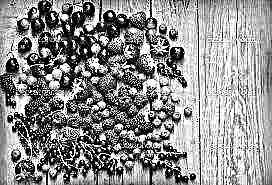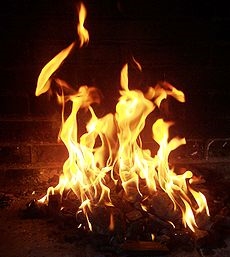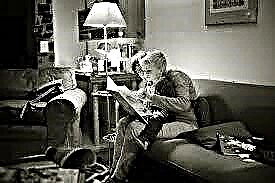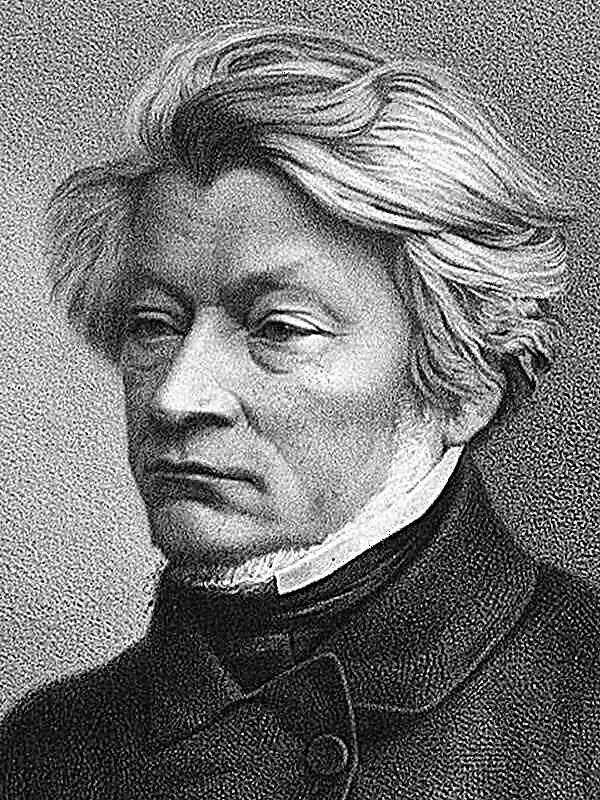Nestor, monk of the monastery of the Pechersky monastery, the legend about why the monastery was nicknamed Pechersky
During the reign of Vladimir Svyatoslavich, a pious husband lived in Lyubec, who wanted to become a monk. He came to the Holy Mount Athos and in one of the monasteries there he accepted monasticism. He was tonsured under the name Anthony. Once the abbot ordered him to return to Russia to serve there as an example for others.
Anthony, having come to Kiev, did not want to settle in any of the monasteries. He found a cave in Berestov, which the Varangians had once dug, and settled there. When Svyatopolk the Cursed became the prince, who killed Boris and Gleb, Anthony again retired to the Holy Mountain.
Soon the pious throne was taken by the pious Yaroslav. At that time, priest Hilarion lived, he served in the Berestovskaya church and even dug up a small cave on one of the Dnieper hills and prayed there. The prince made Hilarion the Metropolitan, and his cave was preserved.
Once the abbot of the Athos monastery, where Antony was, obeying God's voice, ordered Anggonia to go to Russia again. When the monk returned to Kiev, he began to live in a cave dug by Hilarion and pray to God there. Many people came to him for a blessing. Were coming and wanting to become monks.
During the reign of Izyaslav, Anthony had already gathered brothers in twelve people, including St. Theodosius. The monks dug up a large cave. Anthony made hegumen of Barlaam; he himself was accustomed to solitude and therefore made himself a special cave. And the brethren did not fit in the cave. The monks set up a small church on the ground and decided to build a monastery. Anthony blessed this intention, and Prince Izyaslav gave them to build a mountain above the cave. Since then, the monastery has been called Pechersky, because before the monks lived in a cave.
Prince Izyaslav soon transferred Barlaam to the abbess in the monastery of St. Dmitry. Then the brethren elected Theodosius the abbot. Saint Theodosius gathered one hundred monks in the monastery. He introduced the charter of the Greek Studio Monastery in the monastery. Theodosius, among others, tonsured and seventeen-year-old Nestor, who wrote this legend.
About the humble and patient Patron Nikon Chernorizets
A monk named Nikon was captured by the Polovtsy. He was held in fetters. Relatives came to redeem Nikon, but he refused, deciding that it was God's will that he be held captive.
Relatives left, and the Polovtsi, wanting a ransom, began to bug the monk. He was starved, thirsty, kept in the cold in winter. Nikon hoped that the Lord would deliver him. He told the tormentors that he had a dream in which he was told: “In three days you will be in the monastery.” The Polovtsy decided that Nikon wanted to run, cut his shins and guarded him tightly. But on the third day, he suddenly became invisible.
At that moment he found himself in the church of the Caves Monastery. Amazed brothers surrounded the monk. There were fetters on Nikon, and he was all wounded. The monk wanted to hide a miracle, but it was impossible. When he told the brethren about everything, the fetters were removed from him and reforged to the things needed for the altar.
After a while, the Polovtsian, in whom Nikon was in captivity, came to Kiev. In the monastery, he saw his former captive. Then the Polovtsian, along with his clan, was baptized and became a monk.
Nikon could work miracles. When he was captured, his comrades fell ill with hunger, but he healed them with prayer, and they fled, becoming invisible. And once, when the Polovtsian was dying, he ordered Nikon to be crucified over his grave. Nikon healed him by prayer, and delivered himself from death.
About Saint Athanasius the recluse, who died, and the next day came to life again and then lived for twelve years
One brother named Athanasius, who led a holy life, died after a long illness. All day he remained without burial, because he was poor and no one wanted to bury him.
At night, the abbess heard a voice that said that Athanasius lay without burial for the second day. The hegumen with the brethren went to the deceased, but found him alive, sitting in tears. To all questions he repeated only: “Save yourself!” - and advised to remain in obedience and repentance. He lived a recluse in his cave for another twelve years and never spoke to anyone. Before his death, he repeated to the brethren the command of obedience and repentance.
One of the brethren, Babylon, who suffered from pain in his legs, touched the body of Athanasius, was healed. He said that Athanasius appeared to him in a vision and said: "Come, I will heal you."
About Aref the Montenegrin, as the wealth stolen from him by thieves, he was accused of alms, thanks to which he was saved
In the monastery there lived a monk named Arefa, originally a Polovtsian. He was rich, but did not give anything to the poor. Once all his wealth was stolen from him. Arefa began the search and blamed the innocent. The brothers tried to console him and persuaded him not to look for the missing person, but he did not want to listen.
After some time, Aref was seriously ill. Being at death, he saw angels and demons who were arguing about his soul. Angels said that if for the loss of wealth a person thanks God, then this is more alms. Then Arefa exclaimed: "Lord, I have sinned, all yours, but I do not complain." Then the angels recorded the goods stolen from him as alms.
Arefa recovered and told about everything. Since then, his temper has completely changed, and he praised God for everything.
About two brothers who were at war with each other, Titus-priest and Evagriya deacon
There lived two brothers in spirit, Deacon Evagrius and Pop Titus. They loved each other very much, but the devil sowed enmity and hatred between them. So, in enmity, they lived for a long time.
Once Titus became very ill and sent to Evagrius with a prayer for forgiveness. But Evagrius did not forgive and did not want to go to the patient. The elders brought him by force, wanting to reconcile the brothers. The patient with tears apologized, but the deacon mercilessly refused. At these cruel words, Evagrius suddenly fell and died. And Titus just as suddenly recovered.
Then Titus said that at that moment he saw an angel with a spear of fire. An angel struck Evagrius with a spear, and Titus offered his hand and raised it.
About Nikita the Recluse, who was then Bishop of Novgorod
A monk named Nikita lived in the monastery. He wanted to be glorified by people, and began to ask Abbot Nikon for the bolt. The abbot did not allow him. But Nikita did not obey and shut himself in his cell.
A few days later he was seduced by the devil. The demon appeared before the monk in the image of an angel. He ordered Nikita not to pray, but only to read books. Nikita obeyed. Soon he began to prophesy, and glory went about him as a saint.
Nikita knew the Old Testament by heart, but did not even want to hear about the New. And everyone understood from this that he was seduced by the devil. Then the reverend fathers who lived in the monastery drove away the demon from Nikita. The monk immediately forgot the Old Testament and all books in general, so he was hardly taught to read and write.
After that, Nikita became a monk obedient, humble, virtuous, and even miracles could work. He was appointed bishop of Novgorod.
About holy and blessed Agapita, an unselfish doctor
Under blessed Anthony, a Kievite by the name of Agapit accepted monasticism. He always helped and served sick brothers. The Lord gave him the gift of healing. Many patients recovered through his prayers.
At that time there was one skilled doctor, an Armenian by birth and faith. When he saw the hopelessly sick, he immediately predicted the day of death for them, and his words always came true. To one person, he predicted death in eight days. But St. Agapit gave this patient monastery food, and he recovered. Then the Armenian sent a condemned to death to the monastery. In front of Agapit, he was given a deadly potion. Agapit fed the dying man with his food, and he received healing. Then the Armenian, tormented by envy, persuaded his co-religionists to poison Agapit. But the poison did no harm to the saint.
Prince Vladimir Monomakh was seriously ill. The treatment of the Armenian did not help him. The prince began to ask Agapit to come to him. But the monk refused, because he vowed never to leave the monastery, and if he goes to the prince, he will have to go to other patients. The prince's messenger requested that Agapit at least give medicine. Agapit again sent his food, and Vladimir recovered.
Monomakh went to the Pechersky monastery to thank Agapit, but he disappeared. Then the prince sent the boyar with gifts to Agapit, but the monk refused to take anything. Boyarin persuaded the monk to accept gifts for the sake of the prince, he agreed and said that the prince should give all his wealth to the poor. Then Agapit slowly threw away the gifts from his cell. The prince obeyed Agapit and distributed the property to the poor.
Then Agapit himself fell ill. The Armenian came to visit him. He began to talk with the monk about the medical art and realized that Agapit did not understand anything about this. The Armenian told the sick monk that he would die in three days. “If this is not so, then I myself will become a monk,” he added. And Agapit himself said that he would die in three months - so God announced to him.
At this time, a patient was brought to Agapit. The monk got up, as if he were not sick, gave the sufferer his food, and he became healthy. Upon learning that the Armenian doctor was a Gentile, Agapit kicked him out of his cell. The saint died, as predicted, three months later
But the Armenian healer renounced the Armenian faith and became a monk in the Pechersky Monastery. He said that after his death, blessed Agapit appeared to him and reminded him of the promise to accept a monastic image.
About St. Gregory the Wonderworker
Gregory came to the monastery and learned monastic life from St. Theodosius. He could cast out demons.
Once the enemy of the human race taught evil people to steal from Gregory his only wealth - books. Gregory, being in the church, felt that thieves had come to his cell. By his prayer, God sent a dream to the villains. They woke up only five days later. Gregory fed them and let them go. The lord of the city, learning about this, captured the thieves. And Gregory gave the ruler his books to issue these people. He sold the rest of the books so that no one was tempted to steal them, and distributed the money to the poor. Forgiven thieves repented and began to work in the Pechersky monastery.
Another time, thieves wanted to steal the fruits from the garden belonging to Gregory. But, taking the burden, they could not move, and stood there for two days. Gregory said that they, as lovers of idleness, would stand idly for the rest of their days. The thieves vowed that they would now work, not steal. Then the saint let them go, and they, fulfilling their promise, also began to work in the monastery in the garden.
Three people came to the miracle worker Gregory. They said that one of them was sentenced to the gallows, but could get rid of death by means of a ransom. Gregory gave the books to the deceivers, mourning the imminent death of one of them. Liars rejoiced, decided to sell books, and even rob fruit trees in the monastery. They locked St. Gregory in a cave so that he would not interfere with them. One of them (the same false-convict) climbed a tree, but the branch broke off. His comrades rushed to run, and he clung to a branch with a necklace and strangled himself. The next morning, when the brethren released the locked Gregory from the cave, he ordered the dead to be removed, and his comrades said: "So your thought has come true." Repentant liars ended the days in the Pechersky monastery.
When Blessed Gregory went to the Dnieper for water, he met Prince Rostislav Vsevolodich with his brother Vladimir. They were going on a trip to the Polovtsy, and on the way they wanted to go to the Pechersky Monastery. The princely servants began to taunt the saint. And the elder persuaded them to repent, predicting that soon they together with his prince would die in the water. Angry, Prince Rostislav ordered Grigory to be drowned. So the holy miracle worker died. The fraternity searched for him for two days, and on the third day the body of Gregory miraculously appeared in a cave.
Out of fury, Rostislav did not enter the monastery, and his brother Vladimir went. And when, having escaped from the Polovtsy after the battle, the princes crossed the river, Rostislav drowned with his squad, and Vladimir escaped.
About Rev. Moses Ugrin
Blessed Moses was from Hungary. He served Prince Boris. During the killing of Boris, Moses escaped death. He began to live with the sister of Prince Yaroslav, Preslav. The Polish king Boleslav, who went to Russia with the exiled Prince Svyatopolk the Accursed, captured the sisters of Yaroslav and many of the boyars, and with them Moses. He was chained in iron and guarded.
Moses was seen by a young noble widow. She wanted to persuade the young man to commit adultery and was even ready to marry him. But Moses refused - he wanted to maintain mental and physical purity.
Then the woman bought Moses, and he became her slave. She tried to seduce the young man, dressed in precious clothes, fed sweet foods, but this did not lead to anything. The widow decided to starve him, but one of her servants secretly fed Moses. And others were surprised at his perseverance and advised him to marry a noble lady. But Moses strove for monasticism.
The widow conceived to seduce Moses with ambition. He was taken to towns and villages belonging to her, and all bowed to the young man. But he was completely indifferent.
At that time, one monk came from the Holy Mountain. He tonsured Moses as a monk.
The woman began to threaten the youth with death and ordered to beat him with sticks. She turned to King Boleslav, wanting to avenge the slave for her shame. Boleslav ordered the woman to come and bring Moses. Seeing the youth's intransigence, Boleslav allowed a noble widow to do anything with a slave. Moses predicted a near death for him and his mistress.
The widow, desperate in the fulfillment of her desire, ordered Moses to be seized. And Boleslav expelled all the monks from his country. But soon he suddenly died, and a riot broke out in the country, during which Lady Moses was also killed.
Moses came to Kiev, to the Pechersky monastery. He could heal other people from carnal passion.
About Prokhor Chernorets, who made bread from a grass called quinoa, and salt from ashes
During the reign in Kiev, the unrighteous and evil Svyatopolk there were many strife, the Polovtsy raided and there was hunger in the Russian land.
In those days, a man from Smolensk came to the Pechersk abbot John. He took the tonsure and the name of Prokhor. The new monk was distinguished by amazing abstinence: he didn’t even eat bread, but collected the quinoa and baked bread from it. When the great famine came, people, imitating Prokhor, also began to bake bread from quinoa. And Prokhor at that time worked especially hard: he endowed everyone with his bread. If he himself gave this bread, then he was very tasty. And if someone stole bread from Prokhor, then he would become utterly bitter, so that he could not be eaten.
One of the brethren stole bread from Prokhor and could not eat it. This was repeated several times. The delinquent brother told the abbot John of his sin. The bread was bitter. Then the abbot sent to ask Prokhor for bread: that one bread should be taken from his hands, and the other secretly. When these two loaves were brought to the abbess, the stolen one changed before his eyes: he looked like the earth, and tasted bitter. After this miracle, the glory of Prokhor passed all over the earth.
When the strife began due to the blinding of Prince Vasilk, salt was not available in the whole Russian land, because the merchants were not allowed in. And Prokhor collected a lot of ashes, distributed them to those who came to him, and this ashes by the prayer of a saint turned into salt. He distributed this salt to everyone free of charge, so the price of salt fell sharply on the market. Selling salt came to Prince Svyatopolk and began to complain about Prokhor. The prince decided to take the salt from the monk and sell it at a high price. But when salt was taken from Prokhor, they saw that it was just ashes.
The prince kept this ashes for three days, and then ordered him to be thrown away.He immediately turned into salt, and the townspeople gathered it. The prince, learning about this miracle, went to the Pechersky monastery and repented to hegumen John (although he had previously been at enmity with John and even tried to imprison him in Turov).
Since then, Svyatopolk began to love and honor the holy monastery, especially Prokhor. He promised not to do evil again and asked Prokhor to put him in the coffin with his own hands if the prince died earlier. And if Prokhor died earlier, then the prince himself will put him in a coffin.
When Prokhor was ill, the prince was at war. The saint sent to him with a request to come and fulfill his promise. Svyatopolk dismissed the army, came to Prokhor. He instructed the prince before his death. When Prokhor died, Svyatopolk laid his body in a coffin. After that, he continued the war and defeated the enemies.
Since that time, when Svyatopolk went to war, he always first came to the monastery to worship the saints buried there.
About the Monk Spiridon the Prospector and the Alimpius Icon Painter
Spiridon came to the monastery from the village; he quickly learned books. At the command of Abbot Spiridon, he baked prosphora and at the same time incessantly sang the Psalter.
Once Spiridon flooded the stove, and the roof of the bakery lit up from the flame. Then Saint Spyridon tied the sleeves at his shirt, ran to the well and poured water into the shirt. Miraculously, the water did not pour out of the shirt, and Spiridon managed to extinguish the flame.
Reverend Alimpius parents gave to study icon painting. This was when Greek icon painters painted the churches of the Pechersk Monastery.
Masters decorated the church’s altar with mosaics, and suddenly a radiant image of the Virgin appeared by itself. A white dove flew out of the mouth of the Virgin and flew into the mouth of the Savior. Artists tried to find a dove in the church, but in vain. Then they saw the miracle happen again. And Alimpius, who helped the masters, saw this.
Under Mother Superior Nikon, Alimpius took the tonsure. He learned a lot about icon painting skills, painted many icons and took nothing for it. Alimpius also updated dilapidated icons and put them in their place. Hegumen made him a priest.
One wealthy Kiev was a leper. Doctors could not cure him. A friend persuaded the leper to go to the Pechersky monastery. There he was washed and given water from the well of St. Theodosius. But because of his unbelief, the leper got sick even more.
After thinking about his sins, the patient came to the Monk Alimpius and repented. Alimpius forgave him sins and painted his face with paints, glossing over the scabs and giving him his former beauty. Then the leper took communion, bathed in holy water, and immediately received healing.
Another husband from Kiev set up a church and wanted to make icons for it. He gave the two monks money and icon boards to give all this to Alimpius, and he would write the icons. The monks took the silver, but Alimpiya did not say anything. They lied to the customer that Alimpius required more money. The man gave more money, and the monks again appropriated them and wasted. The same thing was repeated a third time, and then the monks declared that Alimpius took the money, but did not want to write icons.
Then the offended customer with the squad went to the monastery and began to complain about Alimpiya. Alimpius was only surprised because he knew nothing. The abbot ordered to bring the monks who took the money and bring the icon boards. The deceivers continued to slander Alimpius that he did not want to paint icons. But the icons, to everyone's amazement, were already painted - created by God himself.
The monks-deceivers were expelled from the monastery, but they did not stop slandering: now they claimed that they themselves had painted icons. But miracles showed that these icons were not simple. The church where they were burnt, but the icons remained intact. Prince Vladimir, learning about this, took one of the icons and sent it to Rostov, to the church there. This church collapsed, but the icon is preserved. She was placed in a wooden church, which burned down, but the fire did not touch the icon.
One person ordered Alimpiya icon for the holiday. The icon painter fell ill, the icon remained unwritten, the customer mourned and bothered the saint. He advised to trust in God: the icon will be ready on time. The customer came to Alimpiy on the eve of the holiday, and the reverend was very ill. A man began to rebuke Alimpius: why, they say, did not warn him, he would transfer the order to another icon painter. The customer left in sorrow, and an angel appeared in the monk’s cell and began to paint an icon. At first, Alimpius thought that he was a simple man, but the speed of his work showed that it was an angel. The icon was completed in three hours.
And in the morning the man who ordered the icon went to his church the next morning and, seeing a radiant new icon, fell from fear. He came to the abbess of the monastery and spoke of a miracle. All together they hastened to Alimpius and saw that he was dying. He was asked about the creation of the icon, and the reverend said that it was painted by an angel. This angel, ready to take a soul, was seen by Alimpius at his bed. When the holy icon painter died, his body was laid in a cave with the reverend fathers.












